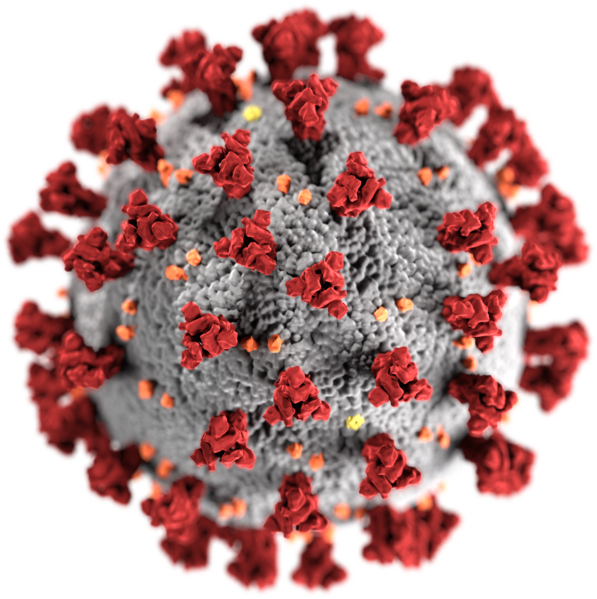
Image: CDC/ Alissa Eckert, MSMI; Dan Higgins, MAMS, Public Domain, via Wikimedia Commons
Israel is bracing itself for a new coronavirus wave as infections across the country surge. The Palestinian Authority also reported a big jump in infections in the West Bank.
The news comes as both the Israeli government and the PA attempt to wrestle with the economic fallout caused by the pandemic.
In more positive news, however, Jerusalem’s Hadassah Medical Center announced today it has treated its first covid-19 patient with a new “passive vaccine”. “The patient reacted positively,” said the hospital’s head, Zeev Rotstein. “She started to improve hemodynamically… We have our fingers crossed for the successful treatment of this patient.”
The treatment, which has been developed in conjunction with the Israeli biopharmaceutical firm Kamada, involved an antibody which was made using plasma that Hadassah took from former coronavirus patients who have recovered from the disease and tested negative.
Yesterday, an Israeli military taskforce warned that the country may experience a doubling in the number of active cases within seven days.
The Israeli Health Ministry said on Tuesday evening that the number of coronavirus cases in the country had risen by 459 within the past 24 hours. This marks the largest 24-hour spike since 22 April, when 556 new cases were confirmed. Israel now has 5,299 active cases, 40 of them in serious condition and 37 on life support. The total number of Israelis who have died from covid-19 stands at 308.
Over the past week, Israel has seen at least 200-300 new cases each day. Last month, the number of new cases in Israel had fallen to several dozen per day. The number of patients in a serious condition is also currently rising.
In response, on Wednesday morning, the government ordered a partial lockdown of two cities: Elad, an ultra-Orthodox town in central Israel, and five predominantly ultra-Orthodox neighbourhoods in the northern city of Tiberias. The areas have been declared “restricted zones” for the next seven days. Although there are some exceptions, entry into and out of the affected areas is heavily restricted and checkpoints have been established. Ministers are said to be discussing whether to also lockdown Bat Yam, near Tel Aviv. The city, which has a large elderly population, has seen a worrying spike in infections.
The prime minister, Benjamin Netanyahu, indicated on Tuesday that the government would consider renewing a controversial Shin Bet tracking programme for virus carriers if rates continue to rise. The secret service and some health officials are believed to oppose such a move.
The IDF’s Coronavirus National Information and Knowledge Centre said this morning that infection rates were “very high” in ultra-Orthodox communities in comparison to the rest of the country. Around 14 percent of all new infections this week have been diagnosed in five locations. The taskforce said approximately one-fifth of covid-19 patients in Israel are from the ultra-Orthodox community. It suggested that dense living conditions, difficulties in isolating patients and connections between different communities around the country were exacerbating the infection rate among the ultra-Orthodox.
Alongside Elad and the neighbourhoods of Tiberias which have already been locked down, attention is focused on high infection rates in the heavily ultra-Orthodox cities of Bnei Brak, Modiin Illit, Beitar Illit and Beit Shemes, as well as ultra-Orthodox neighborhoods in the cities of Jerusalem, Ashdod, Netanya and Safed.
Dr Gili Regev-Yochay, director of Sheba Medical Centre’s Infectious Disease Epidemiology Unit, suggested on Israeli TV: “We can see today where things are headed three weeks from now… we’re not sufficiently prepared.” She also criticised the behaviour of both the government and the public as cases rise and said that reopening the country so quickly “may have been a mistake”.
The taskforce said in its report on Tuesday that Israel’s infection rate is surging by eight percent each day. The number of active cases, it warned, is currently doubling every nine days. On Saturday, the centre said that Israel has entered a second wave of infections. It warned that if immediate steps were not taken to bring numbers down, there could be 1,000 new cases a day and hundreds of new deaths in a month’s time. However, some experts, the Health Ministry and the IDF itself are reported to view the forecast as alarmist and potentially inaccurate.
On Sunday, the Health Ministry ordered hospitals to prepare to reopen their coronavirus wards. The head of the ministry’s General Medicine Division instructed hospital administrators to prepare for an “extreme scenario”.
On Monday, the PA reported the highest single-day increase in cases in the West Bank since the onset of the pandemic. Health officials have warned that the 168 new infections may constitute the onset of a “second wave”. It is believed to have begun last Wednesday, when 45 new cases were confirmed by the PA’s Health Ministry. The total number of coronavirus cases in the West Bank was 742 on Tuesday evening. Two people from the West Bank have died of covid-19. The PA health minister cautioned last week that the situation was particularly worrying because the source of the outbreak has not been identified.
“What will make this second wave more dangerous than the first is the number of virus hotspots of unknown origin and the number of infected medical personnel,” Mai al-Kaila suggested.
The PA has acted swiftly in the face of the surge, banning social gatherings on Saturday and placing two local authority areas – Hebron (which has over half of the West Bank’s total number of cases) and Nablus – under lockdown. Mosques and churches were also closed. The PA did, however, allow a large demonstration against Israeli plans to annex parts of the West Bank to go ahead on Saturday, with few signs that social distancing was observed.
The new wave comes amid grim economic news in both Israel and the West Bank.
In Israel, 500,000-700,000 people have already lost their jobs due to the impact of the coronavirus. In all, over 1,000,000 Israelis have either become unemployed or were put on unpaid leave during the country’s tight lockdown. Unemployment, which was four percent before the crisis began, surged to over 24 percent. It is expected to drop – but remain at over seven percent – by the end of the year.
On Monday, the Employment Bureau reported that some 350,000 people have returned to work since the government began to reopen the economy on 19 April, but 123,400 people have registered as new unemployed. Moreover, although forecasts show a net gain of nine percent for employment in the second quarter of 2020, that is thought likely to be largely wiped out in the third quarter, which is expected to see a seven percent loss in jobs.
Also on Monday, the Central Bureau of Statistics released figures for May showing Israel’s long-term unemployment rate is increasing.
A survey by Manpower Israel released on Tuesday showed employers planning to cut jobs in all seven sectors of the economy, with manufacturing companies reporting plans to cut jobs by 17 percent. Construction, finance, hospitality and retail companies all reported that they would axe posts.
On Monday, the labour, social welfare and social services minister, Itzik Shmuli, warned that half a million Israelis will see their unemployment benefits come to an end – leaving them “newly poor” – at the end of July. The Finance Ministry had extended benefits – which normally last from 50 to 175 days depending on an individual’s previous employment history – during the lockdown. However, it is now planning to switch to a strategy of paying grants to companies which rehire those they have placed on unpaid leave. Shmuli, one of two Labor ministers in the “unity government”, said that he had requested a meeting of the cabinet to discuss the social and economic impact of the coronavirus.
The fallout from the virus is also bleak in the West Bank. Earlier this month, the World Bank warned the Palestinian economy could slump by as much as 11 percent. It also forecast that falling tax revenues and increased health spending could leave the PA with a $1.5bn hole in its finances. In its last pre-pandemic report, the bank had projected 2.5 percent growth in the Palestinian economy. But its new report warned: “We now project a full-year decline of at least 7.6 percent, based on a gradual return to normality from [coronavirus] containment and up to 11 percent in the case of a slower recovery or further restrictions due to another outbreak.” While praising the PA for the “decisive action” it took to tackle the pandemic, the bank also warned of a sharp rise in unemployment.
The PA has been unable to pay its own employees – whose wages make-up around one-fifth of Palestinian GDP – for weeks.
The economic crisis in the West Bank is also set to worsen. Last week, the PA said that it wouldn’t accept the monthly tax transfer it receives from Israel. The transfer – which since the start of the pandemic has constituted 85 percent of the PA’s budget – is tax collected on behalf of the PA by Israel. But, in protest against Netanyahu’s efforts to annex parts of the West Bank, the PA has severed relations with Israel and is now refusing to accept the tax transfers and offers of a loan to help tide it over.
For both Israel and the West Bank, the current economic and health crises may next week be compounded by a political and security crisis if Netanyahu presses ahead with plans to begin annexing parts of the West Bank.

